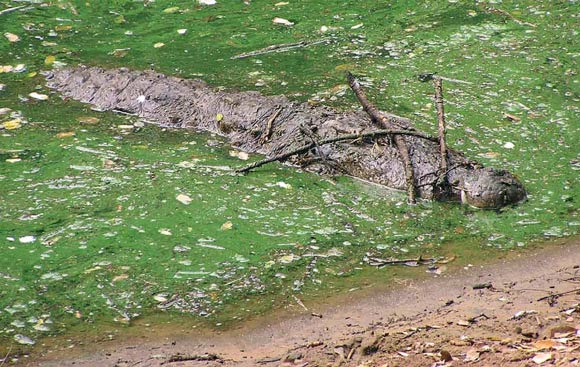US researchers led by Dr Vladimir Dinets from the University of Tennessee have found that two croc species – mugger crocodiles (Crocodylus palustris) and American alligators (Alligator mississippiensis) – use twigs and sticks to lure birds, particularly during nest-building time.

A mugger crocodile balances twigs on its nose to tempt birds collecting small branches to build nests with, at Madras Crocodile Bank, Tamil Nadu in India. Image credit: Vladimir Dinets.
Their study, published in the journal Ethology, Ecology and Evolution, is the first report of tool use by any reptiles, and also the first known case of predators timing the use of lures to a seasonal behavior of the prey.
Dr Dinets first observed the behavior in January 2007 when he spotted mugger crocodiles lying in shallow water along the edge of a pond in India with small sticks or twigs positioned across their snouts.
The behavior potentially fooled nest-building birds wading in the water for sticks into thinking the sticks were floating on the water. The crocodiles remained still for hours and if a bird neared the stick, they would lunge.
To see if the stick-displaying was a form of clever predation, Dr Dinets with colleagues from St Augustine Alligator Farm Zoological Park in Florida performed systematic observations of the reptiles for one year at four sites in Louisiana, including two rookery (a bird breeding ground) and two nonrookery sites.
They observed a significant increase in American alligators displaying sticks on their snouts from March to May, the time birds were building nests. Specifically, the reptiles in rookeries had sticks on their snouts during and after the nest-building season. At non-rookery sites, the reptiles used lures during the nest-building season.
“This study changes the way crocodiles have historically been viewed. They are typically seen as lethargic, stupid and boring but now they are known to exhibit flexible multimodal signaling, advanced parental care and highly coordinated group hunting tactics,” Dr Dinets said.
The observations could mean the behavior is more widespread within the reptilian group and could also shed light on how crocodiles’ extinct relatives – dinosaurs – behaved.
“Our research provides a surprising insight into previously unrecognized complexity of extinct reptile behavior. These discoveries are interesting not just because they show how easy it is to underestimate the intelligence of even relatively familiar animals, but also because crocodilians are a sister taxon of dinosaurs and flying reptiles,” Dr Dinets concluded.
______
Dinets V et al. Crocodilians use tools for hunting. Ethology Ecology & Evolution, published online November 29, 2013; doi: 10.1080/03949370.2013.858276







